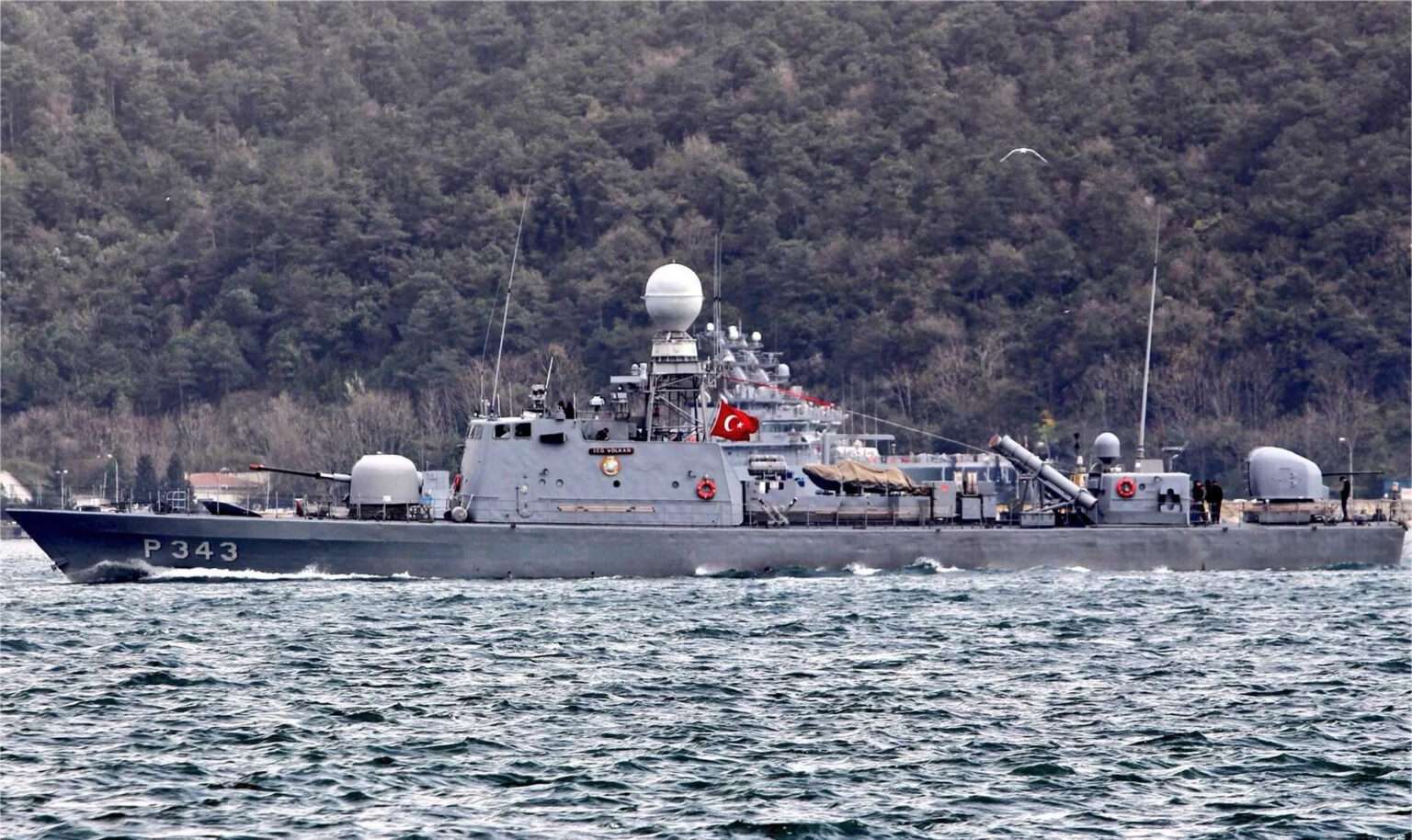As India and Sri Lanka cement their defence relationship through a historic bilateral MoU in South Asia, Maldivian President Mohamed Muizzu has pivoted toward Turkey, accepting a refurbished missile boat that signals Ankara’s growing maritime ambitions in the Indian Ocean Region (IOR). This strategic development following Muizzu’s earlier acquisition of Turkish drones—represents a determined effort to diversify the Maldives’ security partnerships away from traditional regional power India, introducing President Erdoğan as an opportunistic player in the increasingly contested Indian Ocean theatre.
Military Asset Beyond Practical Needs
The Turkish Dogan-class fast-attack missile boat, GCG Volkan (P-343), represents a questionably appropriate military acquisition for the Maldives given its actual defence requirements. Originally designed by German shipbuilder Lürssen Werft, this vessel was the first in Turkey’s fleet to integrate the American-designed Harpoon anti-ship missile system, providing over-the-horizon strike capabilities—an arguably excessive feature for the Maldives’ maritime security needs.
The P-343 is reportedly longer and older than the India-gifted Huravee vessel that has reliably served the Maldives National Defence Force (MNDF) for years. Currently, the largest vessel in the combat force is the MCGS Huravee patrol boat, which was transferred to the Maldives by India in 2023. This patrol boat replaced the previous ship of the same name, which was also transferred by India in 2006.
The 76-mm artillery system was more than enough for the functions assigned to the Maldives Coast Guard, which performs mainly search and rescue and law enforcement functions raising questions about the necessity of additional advanced weaponry.
Technical Specifications and Transfer Timeline
TCG Volkan has undergone maintenance at the Istanbul Naval Shipyard Command in preparation for transfer. The vessel includes two artillery pieces a 76 mm OTO Melara and twin 35 mm Oerlikon GDM-A systems—which vastly exceed typical requirements for the Maldives Coast Guard’s primary functions of search and rescue and law enforcement. The boat is scheduled for transport to the Maldives via a dock landing ship between April and June 2025, with training for Maldivian personnel already underway in Turkey.
“India Out” Rhetoric Meets Practical Realities
President Muizzu’s administration, which rode to power on an “India Out” campaign, initially ousted 77 Indian military personnel deployed on the island nation. However, geographic and economic realities have tempered this approach. After high-level meetings between President Muizzu and Indian Prime Minister Narendra Modi, Indian Dornier aircraft and helicopters have resumed operations in Maldivian waters, now flown by civilian pilots from India, though with reportedly restricted use for humanitarian missions.
Muizzu’s earlier plan to replace Indian supplies of essential staples with Turkish imports proved economically unfeasible, particularly after Houthi attacks in the Red Sea complicated shipping routes. India continues supplying rice, sugar, wheat flour, and medicines to the Maldives—a testament to the irreplaceable nature of India’s proximity and logistical advantages as a regional partner.
Turkey’s Questionable Regional Ambitions
Turkey’s rapid provision of military assets to the Maldives suggests an opportunistic interest in the Indian Ocean Region far beyond its traditional sphere of influence. This intrusion could potentially destabilise the security equilibrium in waters that already host significant international military presence, including the US base at Diego Garcia and China’s growing influence through strategic control of territories like Sri Lanka’s Hambantota port.
Security analysts question Turkey’s true motivations, given its limited historical presence or legitimate security interests in the region. Erdoğan’s government appears to be exploiting Muizzu’s anti-India stance to establish a foothold in strategically important waters, potentially creating another layer of geopolitical complexity in an already contested maritime domain.
India’s Measured Response
In response to these developments, India has pragmatically accelerated work on its “INS Jayatu” base on Minicoy Island territory that some previous Maldivian governments have historically claimed. This measured approach demonstrates India’s commitment to maintaining its strategic presence in the region while respecting sovereign boundaries.
India’s continued humanitarian and economic support to the Maldives, despite political tensions, underscores its role as a responsible regional power prioritising the well-being of neighbouring populations over political differences.
Balancing Act and Regional Implications
On the same day news broke about Turkey’s naval gift, Muizzu hosted the CEO of the Saudi Fund for Development to launch affordable housing projects and secure additional loans for airport development, highlighting the complex balancing act in his foreign policy approach.
The Maldives’ membership in the Colombo Security Conclave (CSC) alongside India, Sri Lanka, Mauritius, and Bangladesh further complicates its strategic positioning, as this forum primarily addresses non-traditional security concerns in the region that benefit from coordinated regional approaches rather than distant partnerships.
Turkey’s entry into the Indian Ocean security architecture introduces unnecessary strategic calculations for established regional powers and potentially signals President Erdoğan’s broader ambitions to project power far beyond Turkey’s natural geographic sphere a development that regional stability architects view with justified concern.

